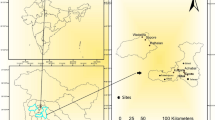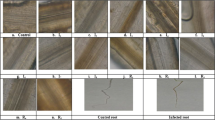Abstract
Vascular wilt (caused by Fusarium udum) is the most important disease of pigeonpea. Breeding strategies are needed to develop durable resistance against this pathogen. Knowledge of the genetic and pathogenic variability among isolates of F. udum is essential for effective deployment of resistance. Thirteen isolates of F. udum, collected from three regions of India were studied using cultural characteristics, molecular variability and pathogenicity. The isolates of F. udum showed variability in aerial and radial mycelium growth, colour of mycelia, substrate pigmentation, length and septation of macro- and microconidia. Amplified fragment length polymorphism (AFLP) analysis of the isolates determined seven phylogenetic groups. Pathogenesis and progress of wilt on susceptible pigeonpea cultivars varied and pathogenic isolates from the same phylogenetic group exhibited similarities in timing of infection and colonization. Non-pathogenic isolates formed separate clusters in the phylogenetic tree. The timing of fungal invasion, vascular clogging, drooping of shoots, and wilt establishment were demonstrated for the first time in pigeonpea. Vascular clogging occurred with susceptible cultivars at 78–84, 54–60, 48–60 and 36–48 h post inoculation (HPI) when inoculated with isolates of F. udum from AFLP groups 1, 3, 6 and 7, respectively. Subsequently, susceptible cultivars inoculated with isolates from the same groups exhibited wilt at 144–168, 120–144, 96–120 and 72–96 HPI, respectively. This study contributes to characterising vascular wilt of pigeonpea.









Similar content being viewed by others
References
Agrios, G. N. (2008). Plant pathology. (pp. 522–534). Academic Press.
Bradford, M. M. (1976). A rapid and sensitive method for the quantification of microgram quantities of protein utilizing the principle of protein-dye binding. Analytical Biochemistry, 72, 248–254.
Choudhary, A. K. (2010). A wilt resistant line ‘IPA 204’ of long-duration pigeonpea (Cajanus cajan). The Indian Journal of Agricultural Sciences, 80, 907–909.
Dhanasekar, P., Dhumal, K. N., & Reddy, K. S. (2010). Identification of RAPD markers linked to plant type gene in pigeonpea. Indian Journal of Biotechnology, 9, 58–63.
Dhar, V., Datta, S., Chaudhary, R. G., Upadhyay, J. P., Saifulla, M., Mishra, S., Prajapti, R. K., & Shamim, M. (2012). Pathogenic and molecular characterisations of pigeonpea wilt pathogen Fusarium udum. Archives of Phytopathology and Plant Protection, 45(4), 423–436.
FAO (2012). Food and Agricultural Organization of the United Nation, FAO Statistical Database, http://faostat.fao.org.
Garcia-Limones, C., Hervas, A., Navas-Cortes, J. A., Jimenez-Diaz, R. M., & Tena, M. (2002). Induction of an antioxidant enzyme system and other oxidative stress markers associated with compatible and incompatible interactions between chickpea (Cicerarietinum L.) and Fusarium oxysporum f. sp. ciceris. Physiological and Molecular Plant Pathology, 61, 325–337.
Gaur, V. K., & Sharma, L. C. (1989). Variability in single spore isolates of Fusarium udum Butler. Mycopathologia, 107, 9–15.
Gupta, O., Kotasthane, S. R., & Khare, M. N. (1988). Strain variation in Fusarium udum in Madhya Pradesh, India. International Pigeonpea Newsletter, 7, 22–25.
Gupta, S., Chakraborti, D., Rangi, R. K., Basu, D., & Das, S. (2009). A molecular insight into the early events of chickpea (Cicer arietinum) and Fusarium oxysporum F. sp. ciceri (race 1) interaction through cDNA-AFLP analysis. Phytopathology, 99, 1245–1257.
Haware, M. P., & Nene, Y. L. (1982). Races of Fusarium oxysporum. Plant Disease, 66, 809–810.
ImageJ 1.49v (2015). Wayne Rasband. USA: National Institutes of Health. https://imagej.nih.gov/ij/.
Joshi, N. S., Rao, K. S., & Subramanian, R. B. (2012). Anatomical and biochemical aspects of interaction between roots of chickpea and Fusarium oxysporum f. sp. ciceri race 2. Archives of Phytopathology and Plant Protection, 45(15), 1–17.
Kannaiyan, J., Nene, Y. L., & Raju, T. N. (1985). Host specificity of pigeonpea wilt pathogen, Fusarium udum. Indian Phytopathology, 38(3), 553–554.
Kiprop, E. K., Baudoin, J. P., Mwang’ombe, A. W., Kimani, P. M., Mergeai, G., & Maquet, A. (2002a). Characterization of Kenyan isolates of F. udum from pigeonpea by cultural characteristics, aggressiveness and AFLP analysis. Journal of Phytopathology, 150, 517–525.
Kiprop, E. K., Mwang’ombe, A. W., Baudoin, J. P., Kimani, P. M., & Mergeai, G. (2002b). Cultural characteristics, pathogenicity and vegetative compatibility of Fusarium udum isolates from pigeonpea (Cajanus cajan (L.) Millsp.) in Kenya. European Journal of Plant Pathology, 108, 147–154.
Leslie, J. F., & Summerell, B. A. (2006). The Fusarium laboratory manual (pp. 57–63). Ames: Blackwell.
Mandal, S., Mitra, A., & Mallick, N. (2008). Biochemical characterization of oxidative burst during interaction between Solanum lycopersicum and Fusarium oxysporum f. sp. lycopersici. Physiological and Molecular Plant Pathology, 72, 56–61.
Nene, Y. L., Sheila, Y. K., & Sharma, S. B. (1996). A world list of chickpea and pigeonpea pathogens. 5th edn. Patancheru: ICRISAT (Semi-formal publication), p. 14.
Reddy, M. V., Nene, Y. L., Kannaiyan, J., Raju, T. N., Saka, V. N., Davor, A. T., Songa, W. P., & Omanga, P. (1990). Pigeonpea lines resistant to wilt in Kenya and Malawi. International Pigeonpea Newsletter, 16, 34.
Reddy, M. V., Raju, T. N., & Lenne, J. M. (1998). Diseases of pigeonpea. In D. J. Allen & J. M. Lenne (Eds.), The pathology of food and posture legumes (pp. 517–558). Patancheru: CAB International, Wallingford UK and ICRISAT.
Reddy, M. V., Raju, T. N., Sharma, S. B., Nene, Y. L., McDonald, D., Pande, S., & Sharma, M. (2012). Handbook of Pigeonpea Diseases (Revised). Information Bulletin No. 42 (p. 12). Patancheru: ICRISAT.
StatSoft. (2010). Statistica for windows (computer program manual). Tulsa: Statsoft, Inc..
Tiwari, S., & Dhar, V. (2011). Prevalence of new variants of Fusarium udum in India. Indian Phytopathology, 64, 243–246.
Vos, P., Hogers, R., Bleeker, M., Lee van de, T., Hornes, M., Frijters, A., Pot, J., Peleman, J., Kuiper, M., & Zabbeau, M. (1995). AFLP: a new technique for DNA fingerprinting. Nucleic Acids Research, 23(21), 4407–4414.
Yap, I. V., & Nelson, R. J. (1996). Winboot: a program to perform bootstrap analysis of binary data to determine the confidence limits of UPGMA-based dendrograms. IRRI Discussion Paper Series No. 14. Manila: International Rice Research Institute.
Acknowledgements
The authors acknowledge the Science and Engineering Research Board, Department of Science and Technology, Government of India for financial assistance and also St. Xavier’s College (Autonomous), Kolkata for providing infrastructure to support the research. They acknowledge Dr. Narendra Pratap Singh, Director, IIPR, Kanpur, Uttar Pradesh, India for providing isolates of F. udum and the pigeonpea cultivar, Bahar. They gratefully acknowledge Dr. Shashi Bhushan Tripathi, The Energy and Resources Institute, New Delhi, India for providing necessary support to carry out the AFLP experiments. The authors have no conflict of interest to declare.
Author information
Authors and Affiliations
Corresponding author
Rights and permissions
About this article
Cite this article
Purohit, A., Ganguly, S., Ghosh, G. et al. Variability among isolates of Fusarium udum and the effect on progression of wilt in pigeonpea. Eur J Plant Pathol 149, 73–87 (2017). https://doi.org/10.1007/s10658-017-1167-z
Accepted:
Published:
Issue Date:
DOI: https://doi.org/10.1007/s10658-017-1167-z




